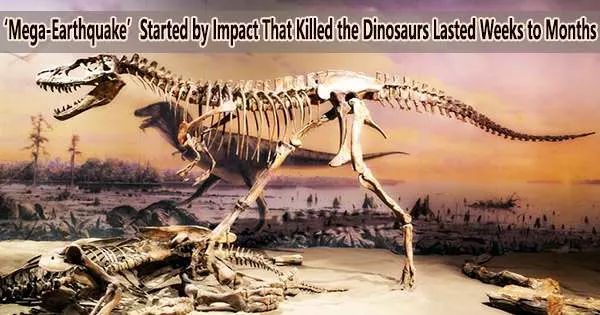A 10-kilometer asteroid that struck Earth 66 million years ago caused the demise of the dinosaurs. According to recent research, the Chicxulub impact also produced an enormous earthquake that shook the earth for several weeks to months after the collision.
This “mega-earthquake” is predicted to have released 1023 joules of energy, which is nearly 50,000 times more energy than the magnitude 9.1 Sumatra earthquake in 2004.
Hermann Bermúdez will present evidence of this “mega-earthquake” at the upcoming GSA Connects meeting in Denver this Sunday, 9 October 2022. Earlier this year, with support from a GSA Graduate Student Research Grant, Bermúdez visited outcrops of the infamous Cretaceous-Paleogene (K-Pg) mass extinction event boundary in Texas, Alabama, and Mississippi to collect data, supplementing his previous work in Colombia and Mexico documenting evidence of the catastrophic impact.
In 2014, Bermdez discovered spherule deposits, which are layers of sediment containing small glass beads (as large as 1.1 mm) and shards are known as “tektites” and “microtektites” that were ejected into the atmosphere during an asteroid impact, while conducting fieldwork on Colombia’s Gorgonilla Island.
These glass beads were created when the impact’s heat and pressure melted and dispersed the Earth’s crust, ejecting tiny, melted blobs up into the atmosphere, which later fell back to the surface as glass due to gravity.
About two kilometers down, the exposed rocks on the coast of Gorgonilla Island tell a tale. Sand, silt, and small sea critters were gathering on the ocean floor there when the asteroid impacted, some 3,000 km southwest of the impact location.
Bermdez credits the soft-sediment deformation that is maintained in the outcrops today in layers of mud and sandstone up to 10-15 meters below the sea bottom to the shaking from the impact.
The spherule-rich layer that formed after the impact is still subject to faulting and deformation from shaking, indicating that the shaking must have lasted for the weeks and months it took for these finer-grained deposits to reach the ocean floor. Preserved fern spores found just above those spherule deposits are the earliest signs of post-impact plant life revival.
Bermúdez explains, “The section I discovered on Gorgonilla Island is a fantastic place to study the K-Pg boundary, because it is one of the best-preserved and it was located deep in the ocean, so it was not affected by tsunamis.”
Evidence of deformation from the mega-earthquake is also preserved in Mexico and the United States. At the El Papalote exposure in Mexico, Bermúdez observed evidence of liquefaction when strong shaking causes water-saturated sediments to flow like a liquid.
In Mississippi, Alabama, and Texas, Bermúdez documented faults and cracks likely associated with the mega-quake. He also documents tsunami deposits at several outcrops, left by an enormous wave that was part of the cascading catastrophes resulting from the asteroid collision.
Bermúdez will deliver a talk about evidence for the mega-earthquake at the GSA Connects meeting in Denver on Sunday, 9 October (2022). He will also present a poster about his observations of tsunami deposits and earthquake-related deformation on Monday, 10 October (2022), which will be available in English, Spanish, Italian, French, and Chinese.
He emphasized the crucial significance that collaboration had in visiting and researching so many outcrops that tell the tale of this dramatic event in Earth’s history when talking about his research.





